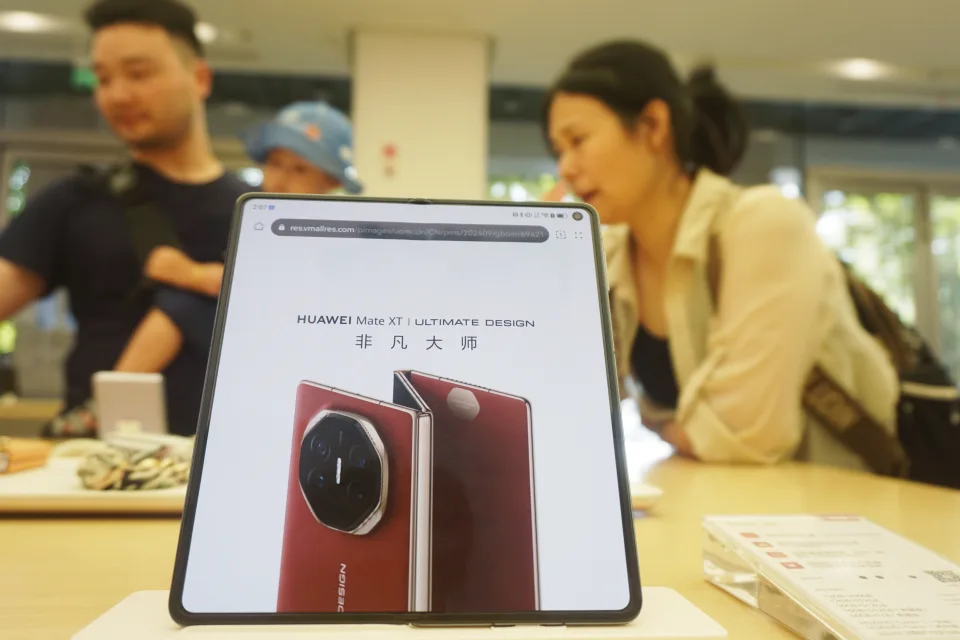In a bold move that showcases its technological prowess, Chinese tech giant Huawei has introduced the Mate XT, touted as the world’s first trifold smartphone. This groundbreaking device was unveiled on Tuesday, mere hours after Apple’s announcement of its new AI-focused iPhone 16, setting the stage for an intense competition in the high-end smartphone market.
The Mate XT’s debut took place at Huawei’s headquarters in Shenzhen, with executive Richard Yu leading the keynote presentation. This innovative device represents a significant leap in foldable phone technology, featuring two folds that allow it to transform from a pocket-sized smartphone into a 10-inch tablet.

Huawei’s latest offering has generated considerable buzz, with over three million people registering interest in purchasing the Mate XT prior to its official launch. The phone is set to hit the market on September 20, with a starting price of 19,999 yuan (approximately $2,800), positioning it firmly in the premium segment.
During the presentation, Yu emphasized Huawei’s leadership in the foldable phone industry, stating, “This is the world’s first triple-folding phone.” He also highlighted the extensive efforts invested in overcoming production challenges and ensuring product reliability, underscoring the complexity of bringing such an innovative device to market.
The Mate XT’s design is a testament to Huawei’s engineering capabilities. When fully opened, the device measures a mere 3.6mm in thickness, excluding the camera bump. This sleek profile is achieved while still offering three distinct modes of operation: a standard smartphone configuration, a nearly square foldable device, and a full 10.2-inch tablet experience. The phone runs on Huawei’s proprietary Harmony OS, further showcasing the company’s commitment to in-house technology development.
Huawei’s strategic timing of the Mate XT’s unveiling, closely following Apple’s iPhone 16 launch, appears to be a deliberate move to assert its position as an innovation leader, particularly in its home market of China. This launch comes at a crucial time for Huawei, as the company has been working to reclaim market share lost due to U.S. sanctions that previously limited its access to critical technologies.

Despite these challenges, Huawei has made a remarkable comeback. Recent data from research firm Canalys shows that Huawei is currently China’s fourth-largest smartphone maker, shipping 10.6 million units in the last quarter. More impressively, the company dominates over half of the domestic market share for foldable phones in the first half of 2024, solidifying its position as a key player in this emerging segment.
The introduction of the Mate XT comes at a time when the smartphone industry is increasingly focused on artificial intelligence capabilities. While Apple’s latest iPhone emphasizes its AI features, Huawei’s approach with the Mate XT appears to prioritize hardware innovation. This divergence in strategies highlights the different paths companies are taking to capture consumer interest and drive sales in a competitive market.
However, industry analysts remain cautious about the broader impact of trifold devices on the smartphone market. IDC analyst Arthur Guo noted that the high technical requirements, low production yields, and elevated prices of trifold products might limit their potential as a major growth driver for the foldable market. He also observed that some phone manufacturers are slowing their investment in foldables, waiting to see if Apple’s eventual entry into the category will stimulate broader consumer interest.
For Huawei, the Mate XT represents more than just a new product launch. The device serves as a symbol of the company’s resilience and technological capabilities in the face of international challenges. Huawei’s ability to develop advanced chips and innovative devices despite U.S. trade sanctions has turned the company into a source of national pride in China. This sentiment has translated into strong sales for Huawei over the past year, as Chinese consumers rally behind the brand.
The Mate XT’s launch also reflects the intensifying competition in the global smartphone market, particularly in the high-end segment. As companies like Huawei push the boundaries of hardware design, others like Apple are focusing on software and AI integration. This diversity of approaches is likely to drive further innovation across the industry, benefiting consumers with a wider range of choices and capabilities in their mobile devices.

As the Mate XT prepares to enter the market, all eyes will be on its reception among consumers and its performance in real-world use. The success of this device could potentially reshape the foldable phone market and influence the direction of smartphone design in the coming years. Regardless of its commercial performance, the Mate XT stands as a testament to Huawei’s commitment to innovation and its determination to remain at the forefront of mobile technology.
Copyright©dhaka.ai
tags: Artificial Intelligence, Ai, Dhaka Ai, Ai In Bangladesh, Ai In Dhaka, Future of AI, Artificial Intelligence in Bangladesh, Mate XT



